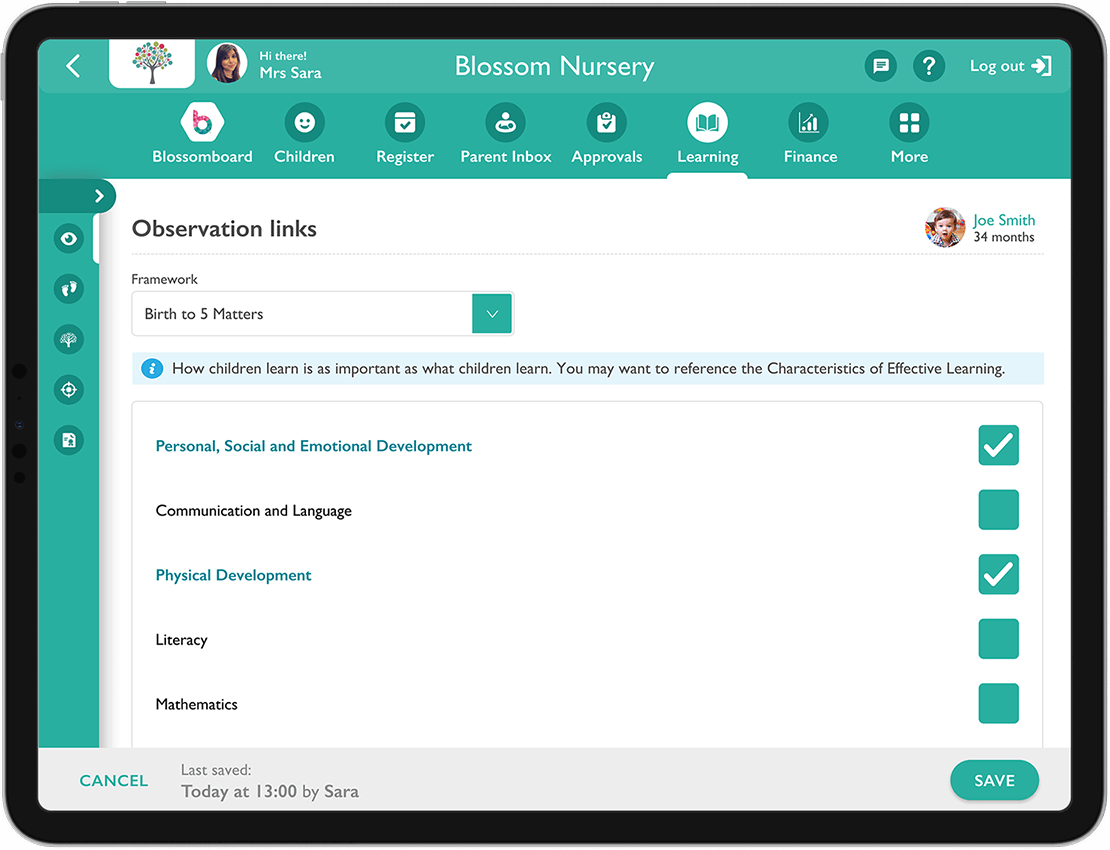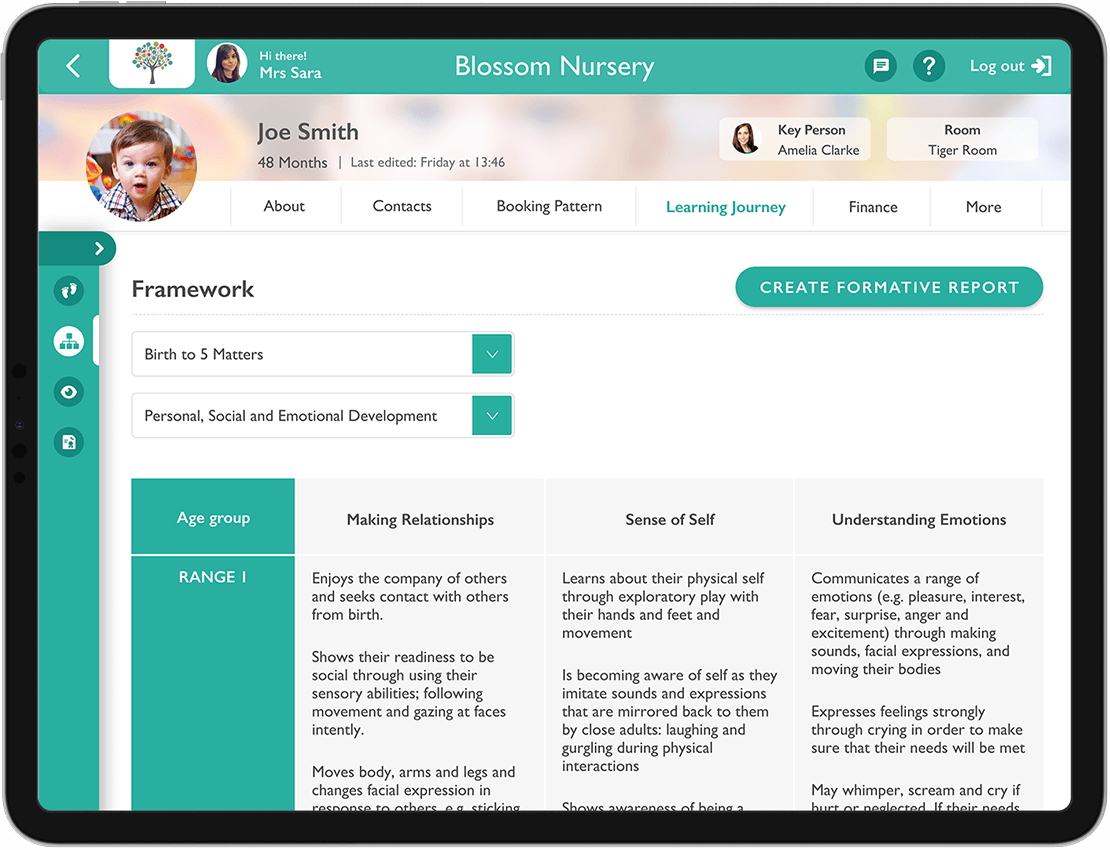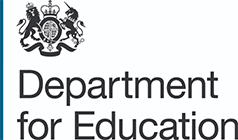All you need to know about the new EYFS Framework
The EYFS Framework changed for nurseries in 2021. See a breakdown of the ‘new’ EYFS Frameworks and the options available to you. From Development Matters 2021 to Birth to 5 Matters, Blossom has you covered.

As you know, the EYFS Framework changed in 2021, altering observation and assessment processes and giving us new curriculum guidance.
The most noticeable shift with the change in framework was the movement away from children meeting standardised criteria. Making nursery assessments and observations more purposeful and tailored to the child’s development rate.
The recognition that children develop and progress at different rates through the EYFS Framework is an important one that we fully support!
What you’ll find on this page
- 1
The EYFS Framework - the latest version
- 2
How can I deliver the 'new' EYFS Framework?
- 3
Which EYFS Frameworks does Blossom support?
- 4
How will each of the frameworks work on Blossom?
- 5
Resources and additional help
The EYFS Framework: the latest version
The large changes to the EYFS Framework came in in 2021, with some minor changes in 2023. The EYFS Statutory Framework is just that, statutory. Meaning all early years providers must follow the guidance, giving all children the same secure foundation for learning in the early years, regardless of the setting they attend.
With the introduction of the new EYFS Framework in 2021 came supporting documents. These documents are not mandatory but are followed by the majority of nurseries when tailoring their EYFS curriculum and assessing children’s progress.
What are the new frameworks?
The new frameworks are:
- Development Matters 2021
- Birth to 5 Matters 2021
What is Development Matters 2021?
Development Matters is non-statutory government guidance, developed by Dr Julian Grenier as well as a range of other early years professionals. The framework uses broad age bands, recognising that children’s development is not strictly regimented. Monitoring and assessing are much more relaxed with far fewer development statements, putting a focus on professional judgement.
The ‘new’ Development Matters (2021) is a more streamlined framework with far fewer statements. This framework aims to highlight key milestones at different developmental stages.
Wider age bands were introduced with this framework, with the purpose of highlighting that learning is not linear. It is recommended to use Development Matters observation checkpoints alongside the new Development Matters, as this will help flag children who may need additional support.
What is Birth to 5 Matters 2021?
Birth to 5 Matters (or Birth to Five Matters) was created by sector experts and the Early Years Coalition. It maintains support for less experienced practitioners, keeping more of the EYFS 2012 development statements. This more rigid structure still cuts down on staff workload, recommending each child receives 3 assessments each year.
The 2021 Birth to 5 Matters framework is most similar to the previous Development Matters framework. If you were particularly familiar and comfortable with the old Development Matters guidance, this framework is the easier transition.
However, Birth to 5 Matters 2021 does not enable you to link children’s progress to statements as you would have done previously. Instead, practitioners can only make observation links to areas of learning.
What does the new guidance focus on?
- The new guidance is trying to move the sector away from a ‘tick list’ culture.
- There is a huge emphasis on reducing staff working load.
- Not having to link Observations to ‘statements’ is prioritised, so there is no need to link to a framework at all.
- Cohort tracking is no longer compulsory.
- There is a large focus on key people knowing their children and having a deeper knowledge of child development.
- The Birth to five Matters and Development Matters 2021 documents are not ‘curriculums’; they are guidance to give you an idea of what children can achieve at different stages.
In summary, it’s all about spending more time with the children.


How can I deliver the ‘new’ EYFS Framework?
The changes that were brought in in 2021 allow more flexibility and freedom to deliver the EYFS Framework how you see best. At Blossom, we recognise the need for flexibility when tracking and monitoring EYFS learning – that’s why you can set a default framework whilst accessing a range of other frameworks (even the really old ones for comparisons).
Which EYFS Frameworks does Blossom support?
In short, all of them! We want our nurseries to have the flexibility to monitor the children in the easiest and most effective way. By allowing all frameworks to be turned on, nursery practitioners and managers can simply mark a child’s progress alongside a statement.
We support:
Development Matters 2021
This is the updated version of the framework with which you will all be familiar. It’s now quite different; although there are the same 7 areas of learning, there are now no aspects. You will see that there are now far fewer statements, and there are broader age bands.
Development Matters 2021:
Observation Checkpoints
This framework provides guidance to help practitioners understand where children are, and to spot signs of developmental delay. It only focuses on PSED, C&L, and PD. This framework still has statements, but even fewer than Development Matters 2021. The age bands are still there. This is for internal use only and information is not shared with parents.
Characteristics of Effective Teaching and Learning
This is part of the new EYFS Development Matters 2021 guidance. This has the 3 original areas: Playing and Exploring, Active Learning Creating, and Thinking Critically (with some updated wording).
Birth to 5 Matters and the updated Characteristics of Effective Learning
This is a new framework, which is very similar to the current Development Matters with which we are familiar. It has the same 7 areas of learning and it retains the aspects (with a couple reworded). It doesn’t have age bands, but it does have six ‘ranges.’ The Characteristics of Effective Learning are almost identical to the CoEL.
Our Montessori framework with links to Development Matters 2021
Our Montessori framework with links to Development Matters 2021
The Old EYFS
We are also keeping the current EYFS, which will now be called ‘EYFS 2012.’ This means that if you are taking a transitory approach, you will be able to continue to use the ‘old’ Development Matters framework.
Development Matters 2021
This is the updated version of the framework with which you will all be familiar. It’s now quite different; although there are the same 7 areas of learning, there are now no aspects. You will see that there are now far fewer statements, and there are broader age bands.
Development Matters 2021:
Observation Checkpoints
This framework provides guidance to help practitioners understand where children are, and to spot signs of developmental delay. It only focuses on PSED, C&L, and PD. This framework still has statements, but even fewer than Development Matters 2021. The age bands are still there. This is for internal use only and information is not shared with parents.
Characteristics of Effective Teaching and Learning
This is part of the new EYFS Development Matters 2021 guidance. This has the 3 original areas: Playing and Exploring, Active Learning Creating, and Thinking Critically (with some updated wording).
Birth to 5 Matters and the updated Characteristics of Effective Learning
This is a new framework, which is very similar to the current Development Matters with which we are familiar. It has the same 7 areas of learning and it retains the aspects (with a couple reworded). It doesn’t have age bands, but it does have six ‘ranges.’ The Characteristics of Effective Learning are almost identical to the CoEL.
Our Montessori framework with links to Development Matters 2021
We have updated our Montessori framework which now includes links to Development Matters 2021.
The Old EYFS
We are also keeping the current EYFS, which will now be called ‘EYFS 2012.’ This means that if you are taking a transitory approach, you will be able to continue to use the ‘old’ Development Matters framework.
- Development Matters 2021 Guidance
- Development Matters 2021
- Development Matters Observation Checkpoints
- Characteristics of Effective Teaching & Learning
- Birth to 5 Guidance
- Birth to 5 Matters
- Characteristics of Effective Learning
How will each of the frameworks work on Blossom?
Using Development Matters
- We have added the new Dev Matters, Observation checkpoints, and CoETL.
- When making Observations you will continue to be able to link to the individual statements. However this is optional - it might be that linking to statements might be more useful for new or less experienced staff.
- Montessoris will have the option of suggested links to the Development Matters 2021 framework which we understand some Montessoris would still like to use as a staff training tool.
- You will continue to be able to use our professional opinion feature, which you are able to use for the Dev Matters and Dev Matters observation checkpoints.
Using Birth to 5 Matters
When making Observations you will not be able to link to the individual statements. Instead you will be able to link to Areas of Learning.
You will not be able to use your professional judgement to mark progress against any statements in the Birth to 5 Matters. This means that the framework page will be available only as a reference point.
Montessoris will not have any suggested links to the Birth to 5 Matters framework.


The observation tracker will now only be based on links to areas of learning.
Statements will not appear in the formative reports and you will now be able to select what range a child is in rather than age bands. You will still be able to select if a child is emerging, expected or exceeding – however, this is optional.
We know nurseries are now encouraged to not use exceeding – there is no requirement for you to do so. We have left the exceeding option for early years settings that may be transitioning away from using this judgement or prefer to use it for those who are mastering a concept.
Although cohort tracking is not compulsory, we understand that some nurseries will continue to track progress. Blossom’s cohort tracking has always been based on practitioners’ judgement which is very much in line with the changes from September. Therefore there are no changes here.

Resources and Additional Support
Useful Links
EYFS Statutory Framework for group and school-based providers
EYFS Statutory Framework for childminders
Summary of changes for group and school-based provisions
To read more guidance and advice about the changes, we recommend the sites below:

